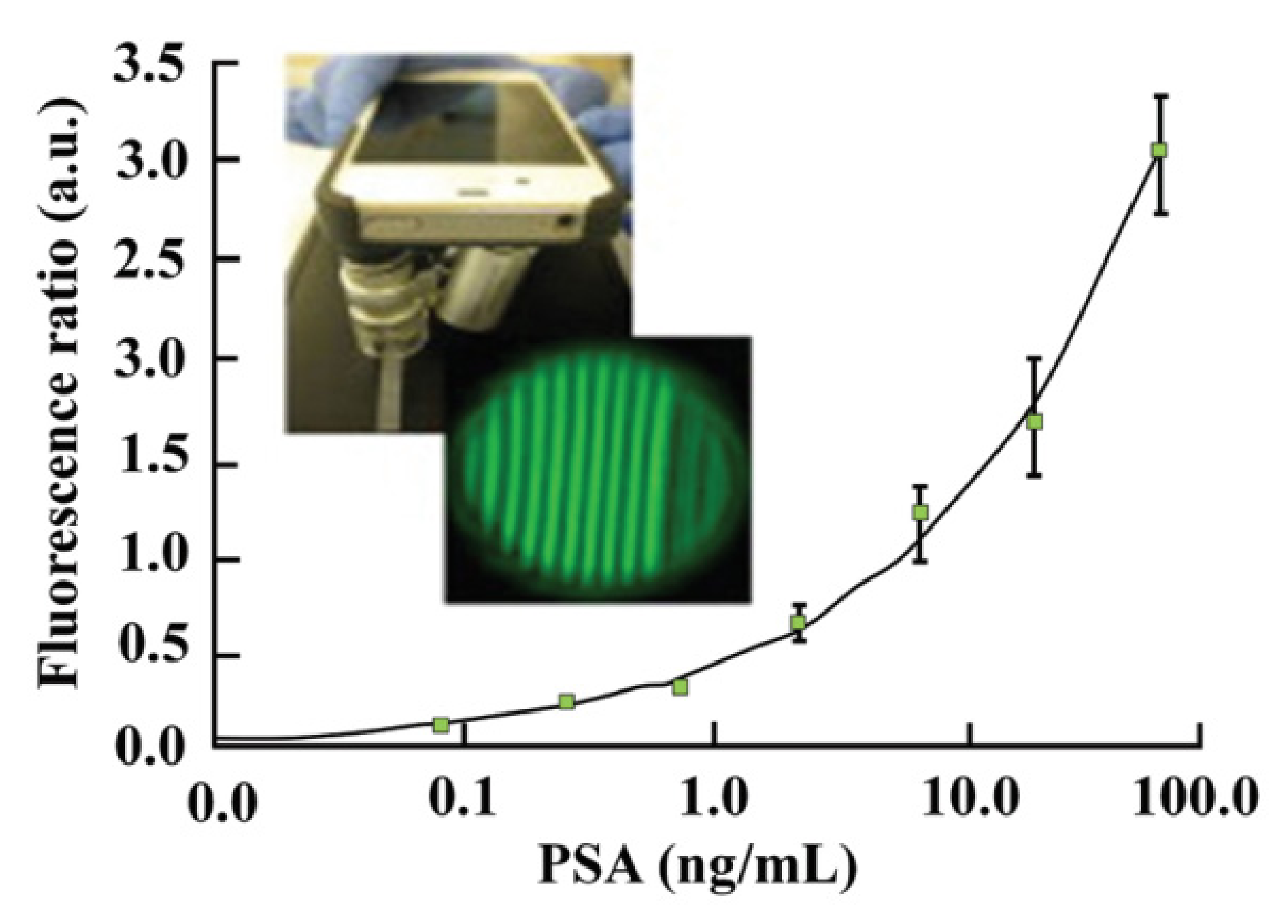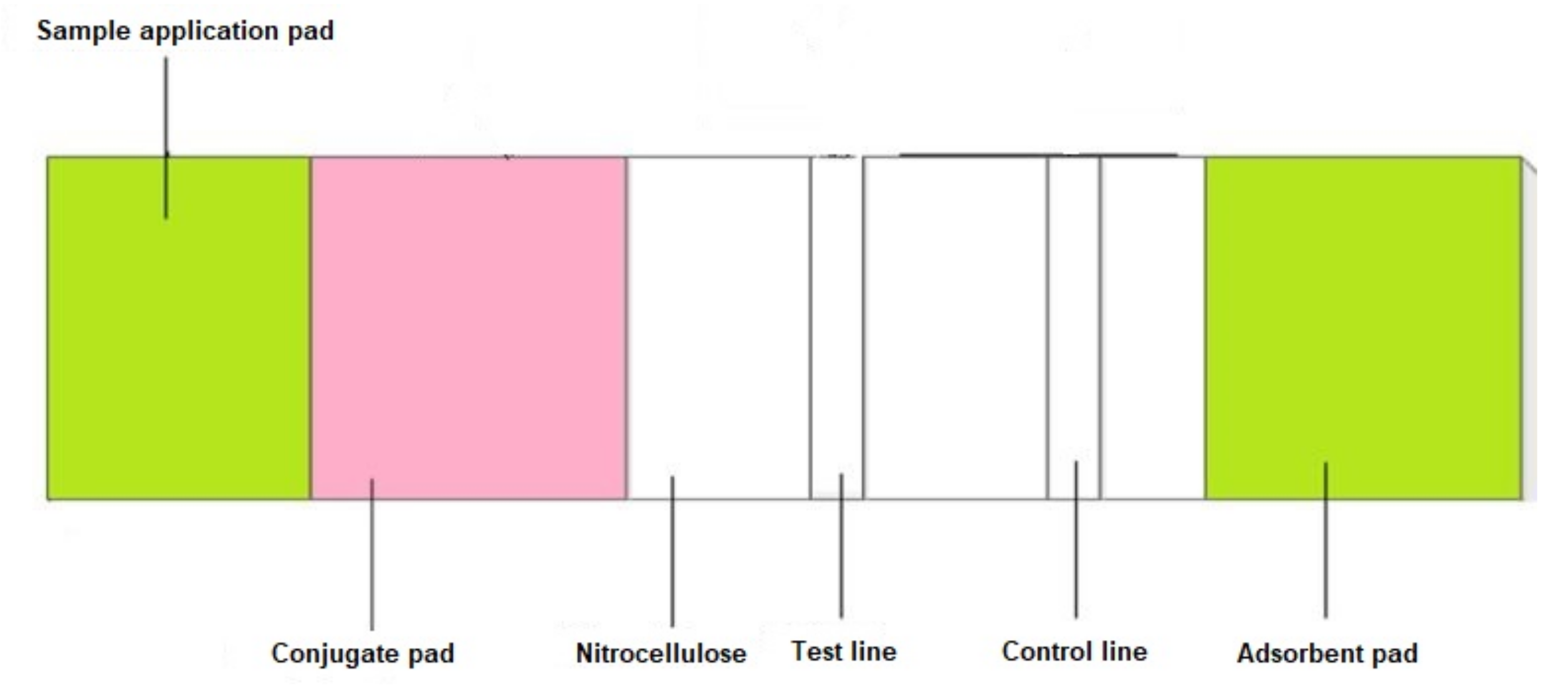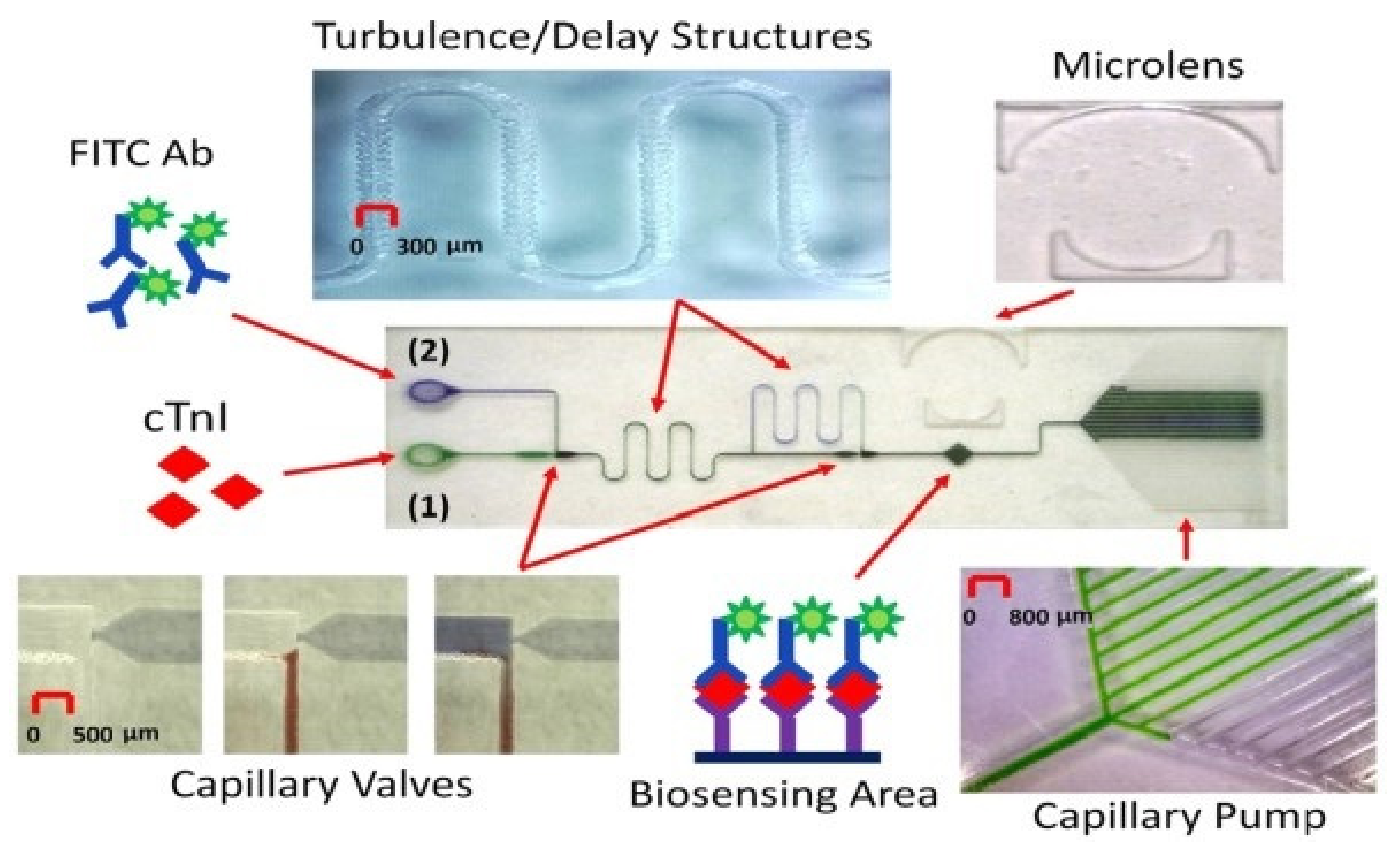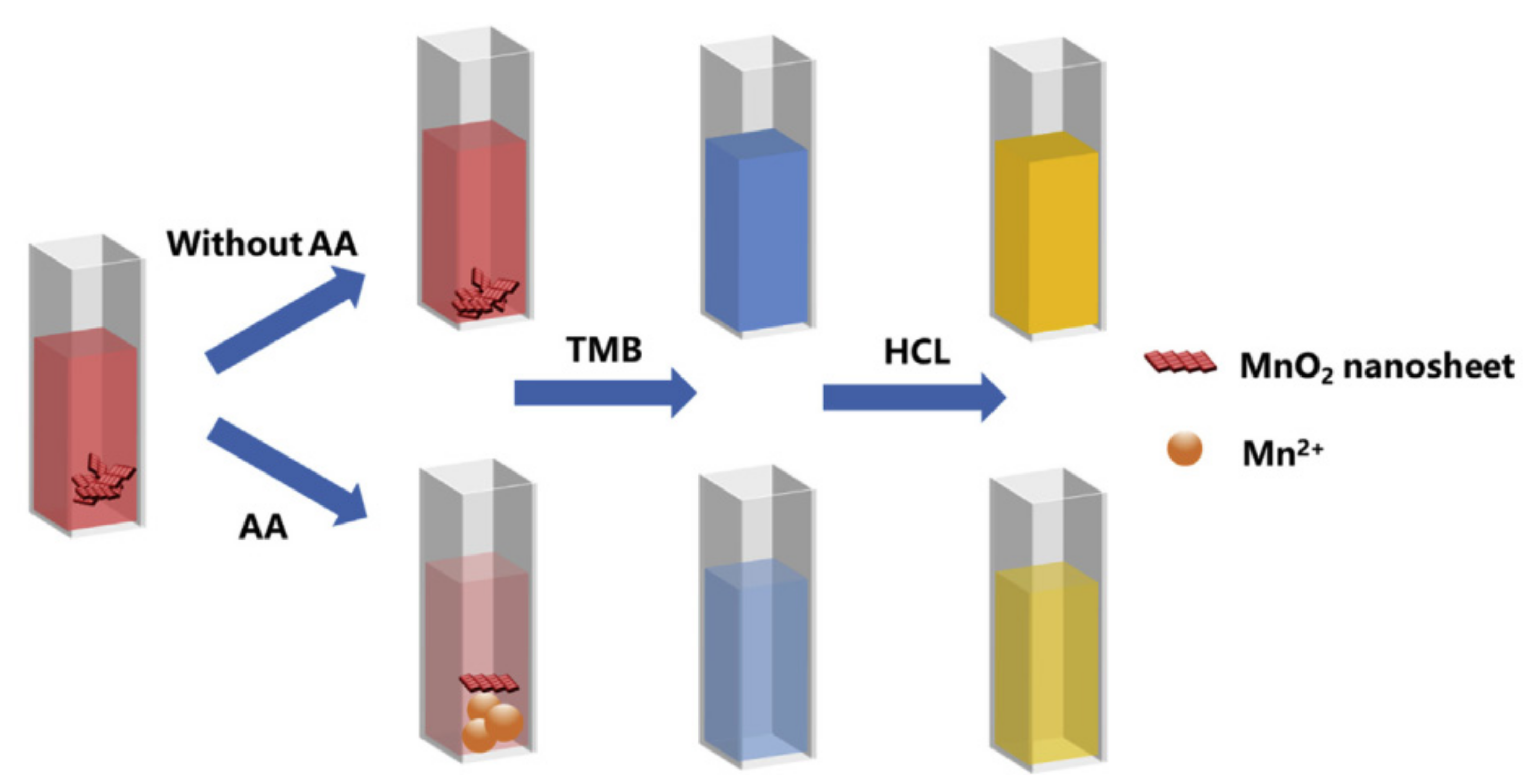Optical-Based Biosensors and Their Portable Healthcare Devices for Detecting and Monitoring Biomarkers in Body Fluids
Abstract
1. Introduction
2. Optical Detection Methods
2.1. Colorimetric
2.2. Luminescence
2.3. Other Biomarker Detection Methods
3. Portable Device Development
3.1. Consumables
3.1.1. Microfluidic Paper-Based Assay
3.1.2. Liquid-Based Detections
3.2. Hardware Support and Analysing Software
3.2.1. Colorimetric
3.2.2. Fluorescence
3.2.3. Chemiluminescence
4. AIE Related Research
5. Discussion and Future Trends
6. Conclusions
Funding
Conflicts of Interest
References
- Biga, L.M.; Dawson, S.; Harwell, A.; Hopkins, R.; Kaufmann, J.; LeMaster, M.; Matern, P.; Morrison-Graham, K.; Quick, D.; Runyeon, J. Chapter 26—Fluid, electrolyte, and acid-base balance. In Anatomy & Physiology; OpenStax: Houston, TX, USA, 2013; pp. 2833–2913. [Google Scholar]
- Bhave, G.; Neilson, E.G. Body fluid dynamics: Back to the future. J. Am. Soc. Nephrol. 2011, 22, 2166–2181. [Google Scholar] [CrossRef] [PubMed]
- Brinkman, J.E.; Dorius, B.; Sharma, S. Physiology, Body Fluids; StatPearls: Treasure Island, FL, USA, 2018. [Google Scholar]
- Zhang, X.; Yao, B.; Hu, Q.; Hong, Y.; Wallace, A.; Reynolds, K.; Ramsey, C.; Maeder, A.; Reed, R.; Tang, Y. Detection of biomarkers in body fluids using bioprobes based on aggregation-induced emission fluorogens. Mater. Chem. Front. 2020, 4, 2548–2570. [Google Scholar] [CrossRef]
- Kong, L.; Gan, Y.; Liang, T.; Zhong, L.; Pan, Y.; Kirsanov, D.; Legin, A.; Wan, H.; Wang, P. A novel smartphone-based CD-spectrometer for high sensitive and cost-effective colorimetric detection of ascorbic acid. Anal. Chim. Acta 2020, 1093, 150–159. [Google Scholar] [CrossRef] [PubMed]
- Abramovitz, M.; Leyland-Jones, B. A systems approach to clinical oncology: Focus on breast cancer. Proteome Sci. 2006, 4, 1–15. [Google Scholar] [CrossRef] [PubMed][Green Version]
- Mayeux, R. Biomarkers: Potential Uses and Limitations. NeuroRx 2004, 1, 182–188. [Google Scholar] [CrossRef]
- Puntmann, V.O. How-to guide on biomarkers: Biomarker definitions, validation and applications with examples from cardiovascular disease. Postgrad. Med. J. 2009, 85, 538–545. [Google Scholar] [CrossRef] [PubMed]
- Ridley, J.W. Introduction to the Study of Body Fluids. Fundam. Study Urin. Body Fluids 2018, 1–7. [Google Scholar] [CrossRef]
- Strimbu, K.; Tavel, J.A. What are biomarkers? Curr. Opin. HIV AIDS 2010, 5, 463–466. [Google Scholar] [CrossRef]
- Cho, Y.-T.; Su, H.; Wu, W.-J.; Wu, D.-C.; Hou, M.-F.; Kuo, C.-H.; Shiea, J. Chapter Six—Biomarker Characterization by MALDI–TOF/MS. Adv. Clin. Chem. 2015, 209–254. [Google Scholar] [CrossRef]
- Sanjay, S.T.; Fu, G.; Dou, M.; Xu, F.; Liu, R.; Qi, H.; Li, X. Biomarker detection for disease diagnosis using cost-effective microfluidic platforms. Analyst 2015, 140, 7062–7081. [Google Scholar] [CrossRef]
- Liu, Y.; Deng, C.; Tang, L.; Qin, A.; Hu, R.; Sun, J.Z.; Tang, B.Z. Specific detection of D-glucose by a tetraphenylethene-based fluorescent sensor. J. Am. Chem. Soc. 2011, 133, 660–663. [Google Scholar] [CrossRef] [PubMed]
- Tagit, O.; Hildebrandt, N. Fluorescence Sensing of Circulating Diagnostic Biomarkers Using Molecular Probes and Nanoparticles. ACS Sens. 2017, 2, 31–45. [Google Scholar] [CrossRef] [PubMed]
- Nimse, S.B.; Sonawane, M.D.; Song, K.S.; Kim, T. Biomarker detection technologies and future directions. Analyst 2016, 141, 740–755. [Google Scholar] [CrossRef]
- Wang, H.; Da, L.; Yang, L.; Chu, S.; Yang, F.; Yu, S.; Jiang, C. Colorimetric fluorescent paper strip with smartphone platform for quantitative detection of cadmium ions in real samples. J. Hazard. Mater. 2020, 392, 122506. [Google Scholar] [CrossRef]
- Hassan, S.-U. Microchip Electrophoresis. Encyclopedia 2020, 1, 6. [Google Scholar] [CrossRef]
- Li, Y.; Liu, X.; Guo, J.; Zhang, Y.; Guo, J.; Wu, X.; Wang, B.; Ma, X. Simultaneous Detection of Inflammatory Biomarkers by SERS Nanotag-Based Lateral Flow Assay with Portable Cloud Raman Spectrometer. Nanomaterials 2021, 11, 1496. [Google Scholar] [CrossRef] [PubMed]
- Tirimacco, R.; St. John, A.; Astill, K.; Weinholt, L.; Merrilees, P. Point of Care Testing Implementation Guide; Australasian Association of Clinical Biochemists Inc.: Alexandria, Australia, 2019. [Google Scholar]
- Gao, Z.; Xu, M.; Lu, M.; Chen, G.; Tang, D. Urchin-like (gold core)@(platinum shell) nanohybrids: A highly efficient peroxidase-mimetic system for in situ amplified colorimetric immunoassay. Biosens. Bioelectron. 2015, 70, 194–201. [Google Scholar] [CrossRef]
- Vilela, D.; González, C.M.; Escarpa, A. Sensing colorimetric approaches based on gold and silver nanoparticles aggregation: Chemical creativity behind the assay. A review. Anal. Chim. Acta 2012, 751, 24–43. [Google Scholar] [CrossRef]
- Gibbs, J.; Vessels, M.; Rothenberg, M. Selecting the Detection System—Colorimetric, Fluorescent, Luminescent Methods for ELISA Assays. In ELISA Technical Bulletin—No 5, Corning Life Sciences; Corning Incorporated: Corning, NY, USA, 2017; pp. 1–14. [Google Scholar]
- Wu, L.; Qu, X. Cancer biomarker detection: Recent achievements and challenges. Chem. Soc. Rev. 2015, 44, 2963–2997. [Google Scholar] [CrossRef]
- Wang, S.; Zhao, X.; Khimji, I.; Akbas, R.; Qiu, W.; Edwards, D.; Cramer, D.W.; Ye, B.; Demirci, U. Integration of cell phone imaging with microchip ELISA to detect ovarian cancer HE4 biomarker in urine at the point-of-care. Lab Chip 2011, 11, 3411–3418. [Google Scholar] [CrossRef]
- Dahl, A.A. Smartphone Enabled Urinalysis Device, Software, and Test Platform. U.S. Patent 15/560,989, 22 February 2018. [Google Scholar]
- Pohl, H. What Is the Difference between Fluorescence, Phosphorescence and Luminescence? 2019. Available online: https://www.enzolifesciences.com/science-center/technotes/2019/december/what-is-the-difference-between-fluorescence-phosphorescence-and-luminescence? (accessed on 8 September 2020).
- Taraska, J.W.; Zagotta, W.N. Fluorescence applications in molecular neurobiology. Neuron 2010, 66, 170–189. [Google Scholar] [CrossRef] [PubMed]
- Yasuda, R. Principle and Application of Fluorescence Lifetime Imaging for Neuroscience: Monitoring Biochemical Signaling in Single Synapses Using Fluorescence Lifetime Imaging. Nanophotonics 2019, 53–64. [Google Scholar] [CrossRef]
- Zhong, W. Nanomaterials in fluorescence-based biosensing. Anal. Bioanal. Chem. 2009, 394, 47–59. [Google Scholar] [CrossRef]
- Bauwant, R.; Kaur, J. Methods and Systems for Diagnosing Sleep Disorders. U.S. Patent 15/510,812, 4 January 2018. [Google Scholar]
- Gabr, M.T.; Pigge, F.C. Rhenium tricarbonyl complexes of AIE active tetraarylethylene ligands: Tuning luminescence properties and HSA-specific binding. Dalton Trans. 2017, 46, 15040–15047. [Google Scholar] [CrossRef]
- Zhang, Z.; Kwok, R.T.K.; Yu, Y.; Tang, B.Z.; Ng, K.M. Sensitive and Specific Detection of l -Lactate Using an AIE-Active Fluorophore. ACS Appl. Mater. Interfaces 2017, 9, 38153–38158. [Google Scholar] [CrossRef]
- Obodovskiy, I. Chapter 12—Luminescence. In Radiation; Elsevier: Amsterdam, The Netherlands, 2019; pp. 207–220. [Google Scholar] [CrossRef]
- Dimitrakov, J.; Buffington, C.A. Methods for Diagnosis of Chronic Prostatitis/Chronic Pelvic Pain Syndrome. U.S. Patent 12/393357, 26 February 2009. [Google Scholar]
- Zhou, X.; Wong, T.I.; Song, H.Y.; Wu, L.; Wang, Y.; Bai, P.; Kim, D.H.; Ng, S.H.; Tse, M.S.; Knoll, W. Development of Localized Surface Plasmon Resonance-Based Point-of-Care System. Plasmonics 2014, 9, 835–844. [Google Scholar] [CrossRef]
- Mao, D.; Wu, W.; Ji, S.; Chen, C.; Hu, F.; Kong, D.; Ding, D.; Liu, B. Chemiluminescence-Guided Cancer Therapy Using a Chemiexcited Photosensitizer. Chem 2017, 3, 991–1007. [Google Scholar] [CrossRef]
- Lippert, A.R.; Krenek, K.M. Composition, Device and Imaging System for Analysis Using Chemiluminescence Probes. U.S. Patent 15/897766, 5 July 2018. [Google Scholar]
- Sun, L.L.; Leo, Y.S.; Zhou, X.; Ng, W.; Wong, T.I.; Deng, J. Localized surface plasmon resonance based point-of-care system for sepsis diagnosis. Mater. Sci. Energy Technol. 2020, 3, 274–281. [Google Scholar] [CrossRef]
- Zhang, Y.; Guo, H.; Kim, S.B.; Wu, Y.; Ostojich, D.; Park, S.H.; Wang, X.; Weng, Z.; Li, R.; Bandodkar, A.J.; et al. Passive sweat collection and colorimetric analysis of biomarkers relevant to kidney disorders using a soft microfluidic system. Lab Chip 2019, 19, 1545–1555. [Google Scholar] [CrossRef]
- Jornet, J.; Feng, L.; Furlani, E.; Gan, Q.; Sun, Z.; Wu, Y. Smart Healthcare System. U.S. Patent 16/956465, 29 April 2021. [Google Scholar]
- De Bock, M.; De Seny, D.; Meuwis, M.A.; Chapelle, J.P.; Louis, E.; Malaise, M.; Merville, M.P.; Fillet, M. Challenges for biomarker discovery in body fluids using SELDI-TOF-MS. J. Biomed. Biotechnol. 2010, 2010, 906082. [Google Scholar] [CrossRef]
- Shah, P.; Zhu, X.; Li, C.Z. Development of paper-based analytical kit for point-of-care testing. Expert Rev. Mol. Diagn. 2013, 13, 83–91. [Google Scholar] [CrossRef]
- Hristov, D.R.; Rodriguez-Quijada, C.; Gomez-Marquez, J.; Hamad-Schifferli, K. Designing paper-based immunoassays for biomedical applications. Sensors 2019, 19, 554. [Google Scholar] [CrossRef]
- Sajid, M.; Kawde, A.N.; Daud, M. Designs, formats and applications of lateral flow assay: A literature review. J. Saudi Chem. Soc. 2015, 19, 689–705. [Google Scholar] [CrossRef]
- Byrnes, S.; Thiessen, G.; Fu, E. Progress in the development of paper-based diagnostics for low-resource point-of-care settings. Bioanalysis 2013, 5, 2821–2836. [Google Scholar] [CrossRef]
- Adel Ahmed, H.; Azzazy, H.M.E. Power-free chip enzyme immunoassay for detection of prostate specific antigen (PSA) in serum. Biosens. Bioelectron. 2013, 49, 478–484. [Google Scholar] [CrossRef]
- Castro-López, V.; Elizalde, J.; Pacek, M.; Hijona, E.; Bujanda, L. A simple and portable device for the quantification of TNF-α in human plasma by means of on-chip magnetic bead-based proximity ligation assay.pdf. Biosens. Bioelectron. 2014, 54, 499–505. [Google Scholar] [CrossRef] [PubMed]
- Mohammed, M.I.; Desmulliez, M.P.Y. Autonomous capillary microfluidic system with embedded optics for improved troponin I cardiac biomarker detection. Biosens. Bioelectron. 2014, 61, 478–484. [Google Scholar] [CrossRef] [PubMed]
- Xie, H.; Wu, Y.; Zeng, F.; Chen, J.; Wu, S. An AIE-based fluorescent test strip for the portable detection of gaseous phosgene. Chem. Commun. 2017, 53, 9813–9816. [Google Scholar] [CrossRef] [PubMed]
- Wang, S.; Ge, L.; Song, X.; Yu, J.; Ge, S.; Huang, J.; Zeng, F. Paper-based chemiluminescence ELISA: Lab-on-paper based on chitosan modified paper device and wax-screen-printing. Biosens. Bioelectron. 2012, 31, 212–218. [Google Scholar] [CrossRef]
- Yang, M.; Kostov, Y.; Bruck, H.A.; Rasooly, A. Gold nanoparticle-based enhanced chemiluminescence immunosensor for detection of Staphylococcal Enterotoxin B (SEB) in food. Int. J. Food Microbiol. 2009, 133, 265–271. [Google Scholar] [CrossRef]
- Chen, A.; Wang, R.; Bever, C.R.S.; Xing, S.; Hammock, B.D.; Pan, T. Smartphone-interfaced lab-on-a-chip devices for field-deployable enzyme-linked immunosorbent assay. Biomicrofluidics 2014, 8, 1–11. [Google Scholar] [CrossRef] [PubMed]
- Coskun, A.F.; Nagia, R.; Sadeghia, K.; Phillips, S.; Ozcan, A. Albumin testing in urine using a smart-phone. Lab Chip 2013, 13, 4231–4238. [Google Scholar] [CrossRef]
- Akraa, S.; Pham Tran Tam, A.; Shen, H.; Tang, Y.; Tang, B.Z.; Li, J.; Walker, S. A smartphone-based point-of-care quantitative urinalysis device for chronic kidney disease patients. J. Netw. Comput. Appl. 2018, 115, 59–69. [Google Scholar] [CrossRef]
- Quimbar, M.E.; Krenek, K.M.; Lippert, A.R. A chemiluminescent platform for smartphone monitoring of H2O2 in human exhaled breath condensates. Physiol. Behav. 2017, 176, 139–148. [Google Scholar] [CrossRef]
- Agu, E.; Pedersen, P.; Strong, D.; Tulu, B.; He, Q.; Wang, L.; Li, Y. The smartphone as a medical device: Assessing enablers, benefits and challenges. In Proceedings of the 2013 IEEE International Conference on Sensing, Communications and Networking, SECON 2013, New Orleans, LA, USA, 24–27 June 2013; pp. 76–80. [Google Scholar] [CrossRef]
- Shen, L.; Hagen, J.A.; Papautsky, I. Point-of-care colorimetric detection with a smartphone. Lab Chip 2012, 12, 4240–4243. [Google Scholar] [CrossRef] [PubMed]
- Oncescu, V.; O’Dell, D.; Erickson, D. Smartphone based health accessory for colorimetric detection of biomarkers in sweat and saliva. Lab Chip 2013, 13, 3232–3238. [Google Scholar] [CrossRef]
- Wang, R.; Ongagna-Yhombi, S.Y.; Lu, Z.; Centeno-Tablante, E.; Colt, S.; Cao, X.; Ren, Y.; Cárdenas, W.B.; Mehta, S.; Erickson, D. Rapid Diagnostic Platform for Colorimetric Differential Detection of Dengue and Chikungunya Viral Infections. Anal. Chem. 2019, 91, 5415–5423. [Google Scholar] [CrossRef]
- Aydindogan, E.; Ceylan, A.E.; Timur, S. Paper-based colorimetric spot test utilizing smartphone sensing for detection of biomarkers. Talanta 2020, 208, 120446. [Google Scholar] [CrossRef]
- Wang, L.X.; Fu, J.J.; Zhou, Y.; Chen, G.; Fang, C.; Lu, Z.S.; Yu, L. On-chip RT-LAMP and colorimetric detection of the prostate cancer 3 biomarker with an integrated thermal and imaging box. Talanta 2020, 208, 120407. [Google Scholar] [CrossRef]
- Mudanyali, O.; Dimitrov, S.; Sikora, U.; Padmanabhan, S.; Navruz, I.; Ozcan, A. Integrated rapid-diagnostic-test reader platform on a cellphone. Lab Chip 2012, 12, 2678–2686. [Google Scholar] [CrossRef]
- Jones, S.L.; Close, C.F.; Mattock, M.B.; Jarrett, R.J.; Keen, H.; Viberti, G.C. Plasma lipid and coagulation factor concentrations in insulin dependent diabetics with microalbuminuria. Br. Med. J. 1989, 298, 487–490. [Google Scholar] [CrossRef]
- Huang, C.; Ma, R.; Luo, Y.; Shi, G.; Deng, J.; Zhou, T. Stimulus Response of TPE-TS@Eu/GMP ICPs: Toward Colorimetric Sensing of an Anthrax Biomarker with Double Ratiometric Fluorescence and Its Coffee Ring Test Kit for Point-of-Use Application. Anal. Chem. 2020, 92, 12934–12942. [Google Scholar] [CrossRef] [PubMed]
- Wei, Q.; Acuna, G.; Kim, S.; Vietz, C.; Tseng, D.; Chae, J.; Shir, D.; Luo, W.; Tinnefeld, P.; Ozcan, A. Plasmonics enhanced smartphone fluorescence microscopy. Sci. Rep. 2017, 7, 1–10. [Google Scholar] [CrossRef] [PubMed]
- Sekine, Y.; Kim, S.B.; Zhang, Y.; Bandodkar, A.J.; Xu, S.; Choi, J.; Irie, M.; Ray, T.R.; Kohli, P.; Kozai, N.; et al. A fluorometric skin-interfaced microfluidic device and smartphone imaging module for: In situ quantitative analysis of sweat chemistry. Lab Chip 2018, 18, 2178–2186. [Google Scholar] [CrossRef]
- Alves, I.P.; Reis, N.M. Microfluidic smartphone quantitation of Escherichia coli in synthetic urine. Biosens. Bioelectron. 2019, 145, 111624. [Google Scholar] [CrossRef] [PubMed]
- Paterson, A.S.; Raja, B.; Mandadi, V.; Townsend, B.; Lee, M.; Buell, A.; Vu, B.; Brgoch, J.; Willson, R.C. A low-cost smartphone-based platform for highly sensitive point-of-care testing with persistent luminescent phosphors. Lab Chip 2017, 17, 1051–1059. [Google Scholar] [CrossRef]
- Ramasubramanian, K.; Jaccob, M.; Velusamy, M. Internet of Things-Enabled Aggregation-Induced Emission Probe for Cu2+ Ions: Comprehensive Investigations and Three-Dimensional Printed Portable Device Design. ACS Omega 2020, 5, 32761–32768. [Google Scholar] [CrossRef]
- Kim, H.; Jung, Y.; Doh, I.J.; Lozano-Mahecha, R.A.; Applegate, B.; Bae, E. Smartphone-based low light detection for bioluminescence application. Sci. Rep. 2017, 7, 1–11. [Google Scholar] [CrossRef]
- Roda, A.; Michelini, E.; Cevenini, L.; Calabria, D.; Calabretta, M.M.; Simoni, P. Integrating biochemiluminescence detection on smartphones: Mobile chemistry platform for point-of-need analysis. Anal. Chem. 2014, 86, 7299–7304. [Google Scholar] [CrossRef]
- Zangheri, M.; Cevenini, L.; Anfossi, L.; Baggiani, C.; Simoni, P.; Di Nardo, F.; Roda, A. A simple and compact smartphone accessory for quantitative chemiluminescence-based lateral flow immunoassay for salivary cortisol detection. Biosens. Bioelectron. 2015, 64, 63–68. [Google Scholar] [CrossRef]
- Chen, X.; Liu, B.; Pang, W.; Duan, X. Smartphone-enabled Dynamic Chemiluminescence Biomarker Quantitation Using Acoustic Tweezers Approach. In Proceedings of the Annual International Conference of the IEEE Engineering in Medicine and Biology Society, EMBS 2020, Montreal, QC, Canada, 20–24 July 2020; pp. 5041–5044. [Google Scholar] [CrossRef]
- Luo, J.; Xie, Z.; Xie, Z.; Lam, J.W.Y.; Cheng, L.; Chen, H.; Qiu, C.; Kwok, H.S.; Zhan, X.; Liu, Y.; et al. Aggregation-induced emission of 1-methyl-1,2,3,4,5-pentaphenylsilole. Chem. Commun. 2001, 18, 1740–1741. [Google Scholar] [CrossRef] [PubMed]
- Zhang, C.; Kim, J.P.; Creer, M.; Yang, J.; Liu, Z. A smartphone-based chloridometer for point-of-care diagnostics of cystic fibrosis. Biosens. Bioelectron. 2017, 97, 164–168. [Google Scholar] [CrossRef] [PubMed]
- Chen, J.; Chen, X.; Zhao, J.; Liu, S.; Chi, Z. Instrument-free and visual detection of organophosphorus pesticide using a smartphone by coupling aggregation-induced emission nanoparticle and two-dimension 2 nanoflake. Biosens. Bioelectron. 2020, 170, 112668. [Google Scholar] [CrossRef] [PubMed]
- Yu, L.; Chen, H.; Yue, J.; Chen, X.; Sun, M.; Tan, H.; Asiri, A.M.; Alamry, K.A.; Wang, X.; Wang, S. Metal−Organic Framework Enhances Aggregation-Induced Fluorescence of Chlortetracycline and the Application for Detection. Anal. Chem. 2019, 91, 5913–5921. [Google Scholar] [CrossRef]







| Biomarker Agents | Pros | Cons | |
|---|---|---|---|
| Colorimetric | Colloidal gold nanoparticles and others. | Optical properties are dependent of the particles’ size and shapes, which are controllable. Friendly to environment. High affinity to biomarkers. High stability with long lasting time. | High selectivity to specific biological markers. |
| Fluorescence | Fluorophores. e.g., rhodamine, AIEgens | Higher sensitivity than colorimetric. Fluorescent intensity can be controlled by managing the excitation light source. | Chemical and metabolic degradation results in short time storage. |
| Chemiluminescence | Enzymes, AIEgens and others | High sensitivity compared to colorimetric and fluorescence. | Rapid reaction and degradable intensity in the final mixture require highly sensitive sensors. Short time storage. |
| Ref | Biological Information | Dry or Liquid Based Testing | Smartphone or Other Devices | Light Source | Data Collecting | Data Analysing | Result |
|---|---|---|---|---|---|---|---|
| [57] | Detect pH level in Urine | Paper test strip | Smartphone (HTC and Blackberry) | White light (5000 K) | Smartphone (CMOS camera) | Computer (MATAB) | LOD: 0.5 in pH value. |
| [59] | Monitor Dengue and Chikungunya Viral infections. | Paper test strip. | Customed device. | White light (7500 K) | Raspberry Pi CMOS image sensor module | Computer (MATAB) | Consistent and accurate in detecting dengue and chikungunya in 30 min. |
| [60] | Detect alpha-fetoprotein and mucin-16 in serum | Customed paper strip. | Smartphone (iPhone 7). | White light (Sunlight). | Smartphone (CMOS camera). | Computer (ImageJ software). | LOD: 1.054 ng/mL for AFP; and 0.413 ng/mL for MUC16. |
| [52] | Detect bovine serum albumin in serum. | Customed microfluidic chip. | Smartphone (NA brand). | NA. | Smartphone (CMOS camera). | Arduino microcontroller (Customed software). | The system can immediately present the analysis result of BSA concentration in serum. |
| [24] | Detect Human epididymis protein 4 biomarker in Urine | Customed microfluidic chip ELISA | Smartphone (Sony Ericson i790) | White light | Smartphone (3.2-megapixel CMOS camera) | Computer (MATAB). | LOD: 19.5 ng/mL of HE4. |
| [58] | Detect Sodium concentration and Enamel decalcification in Saliva | Customed paper strip. | Smartphone (iPhone4 and iPhone 4S) | White light (Camera flash) | Smartphone (CMOS camera)) | Smartphone (Customed app) | Detect the risk of dehydration and evaluate the impact of dietary changes on the risks of enamel decalcification. |
| [5] | Detect ascorbic acid in serum. | Liquid test. | Smartphone (Vivo X7). | Customed light source. | Smartphone (CMOS camera). | Smartphone (Customed app). | LOD: 0.4946 µM for AA in serum. |
| [61] | Measure nucleic acid | Customed paper strip. | Smartphone. | Smartphone’s flashlight | Smartphone (CMOS camera). | Smartphone (Commercial app). | LOD: 0.39 fg/µL for RNA in serum. |
| Camera | Data Type | Resolution | Power Required | Popularity for Researching | Cost | Electronic Support |
|---|---|---|---|---|---|---|
| CCD | Digital | High | High | Medium | High | High. Require electronic circuits to control the camera, to regulate power supply, to convert analog-digital signal, etc. |
| CMOS | Analog | Medium | Medium | High | Medium | Low. Only power supply circuit required. |
| Photodiode | Numeric | Low | Low | Low | Low | Medium. Require power supply circuit and the signal detecting circuit. |
| Light Source | Size | Power Required | Intensity | Light Distribution | Popularity for Researching | Cost | Electronic Support |
|---|---|---|---|---|---|---|---|
| LED | Small | Low | Medium | Scattering | High | Low | Low, only power supply circuit required. |
| Laser diode | Small | Low | High | Focus beam | High | Low | Low, only power supply circuit required. |
| Lamp | Large | High | Extremely high | Scattering | Low | High | High, require complex power supply circuit. |
| Ref | Biological Information | Dry or Liquid Based Testing | Smartphone or Other Devices | Excitation Wavelength | Fluorescent Emission | Data Collecting | Data Analysing | Result |
|---|---|---|---|---|---|---|---|---|
| [65] | NA. | Customed solution test tray. | Smartphone (Nokia 1020). | 465 nm. | Depending on the conjugated reagent. | Smartphone (CMOS camera). | Computer (Commercial app). | LOD: 80 fluorophores/diffraction-limitted spot. |
| [32] | Chloride in sweat | Solution test. | Smartphone (HTC One M9). | 365 nm. | 441 nm. | Smartphone camera. | NA. | LOD: 0.8 nM of chloride in sweat. |
| [62] | Malaria, HIV and tuberculosis (TB) in whole blood. | Commercial paper test strips for each disease. | Smartphone (Samsung Galaxy SII) | 565 nm. | Depending on the disease detections (NA) | Smartphone (CMOS camera) | Smartphone (Customed app) | Correctly and qualitatively detects the infected patients. |
| [53] | Albumin in urine | Solution test. | Smartphone (Samsung Galaxy SII) | 532 nm. | NA | Smartphone (CMOS camera). | Smartphone (Customed app) | LOD: 5–10 µg/mL |
| [66] | Concentration of chloride, sodium and zinc in sweat. | Customed test strip. | Smartphone (iPhone 6 Plus). | 451 nm. | 511 nm for chloride. 515 nm for sodium. 519 nm for zinc. | Smartphone camera. | Smartphone (Customed app) | LOD: 28 mM for chloride; 36 mM for sodium; and 3.6 µM for zinc. |
| [54] | Albumin concentration in urine | Solution test. | Smartphone (iPhone 6s, Samsung Galaxy Note 4, and Galaxy S3). | 340 nm. | ~ 480 nm. | Smartphone (CMOS camera). | Smartphone (Customed app) | Quantitatively detects albumin in urine. |
| [67] | E. coli K12 in urine. | Customed microfluidic chip. | Smartphone (iPhone 6S). | NA. | NA. | Smartphone (CMOS camera). | Smartphone (Customed app). | LOD: 240 CFU/mL for E. coli K12 in urine. |
| [68] | Human chorionic gonadotropin in urine. | Customed paper test strip. | Smartphone (iPhone 5S). | NA. | NA. | Smartphone (CMOS camera). | Smartphone (Customed app). | LOD: 45 pg/mL for hCG |
| [64] | Dipicolinic acid from Bacillus anthracis spores | Customed AIEgen-based paper coffee ring. | Smartphone | 405 nm. | Blue (430–500 nm). Red (580–650 nm) | Smartphone (CMOS camera). | Smartphone (Image J). | LOD: 27 nM for DPA. |
| [69] | Detect Cu2+ in aqueous sample | Solution test | Raspberry Pi-ARM V11 | 365 nm | 510 nm. | Raspberry Pi camera 5 MP | Software DAS-6 from IBH to analyse RBG. | LOD: 9 pM of Cu2+ ion. |
| Ref | Body Fluid | Dry or Solution-Based | Smartphone or Other Devices | Luminant Emission | Data Collecting | Data Analysing | Result |
|---|---|---|---|---|---|---|---|
| [70] | Reporter bacteria OD600 | Solution | Smartphone (OPO OnePlus One) | 490 nm | Smartphone (CMOS camera). | Computer (MATLAB) | LOD: 7.9 × 106 CFU/mL |
| [55] | Airway hydrogen peroxide in exhaled breath condensates. | Solution. | Smartphone (iPhone 6). | 500 nm | Smartphone (CMOS camera). | Smartphone (Customed app) | LOD: 264 nM of H2O2 in human exhaled breath condensates. |
| [71] | Total bile acids and total cholesterol in serum. | Solution. | Smartphone (iPhone 5S). | NA. | Smartphone (CMOS camera). | Smartphone (Commercial app). | LOD: 0.5 µmol/L for total bile acids and 20 mg/dL for total cholesterol in serum. |
| [72] | Salivary cortisol. | Paper test strip. | Smartphone (NA smartphone’s brand). | NA. | Smartphone (CMOS camera). | Smartphone (Customed app). | LOD: 0.3 ng/mL. |
| [73] | Prostate specific antigen in serum. | Customed microfluidic solution chip. | Smartphone (NA smartphone’s brand). | NA. | Smartphone camera. | Smartphone (Customed app). | LOD: 0.1 ng/mL. |
Publisher’s Note: MDPI stays neutral with regard to jurisdictional claims in published maps and institutional affiliations. |
© 2021 by the authors. Licensee MDPI, Basel, Switzerland. This article is an open access article distributed under the terms and conditions of the Creative Commons Attribution (CC BY) license (https://creativecommons.org/licenses/by/4.0/).
Share and Cite
Pham, A.T.T.; Wallace, A.; Zhang, X.; Tohl, D.; Fu, H.; Chuah, C.; Reynolds, K.J.; Ramsey, C.; Tang, Y. Optical-Based Biosensors and Their Portable Healthcare Devices for Detecting and Monitoring Biomarkers in Body Fluids. Diagnostics 2021, 11, 1285. https://doi.org/10.3390/diagnostics11071285
Pham ATT, Wallace A, Zhang X, Tohl D, Fu H, Chuah C, Reynolds KJ, Ramsey C, Tang Y. Optical-Based Biosensors and Their Portable Healthcare Devices for Detecting and Monitoring Biomarkers in Body Fluids. Diagnostics. 2021; 11(7):1285. https://doi.org/10.3390/diagnostics11071285
Chicago/Turabian StylePham, Anh Tran Tam, Angus Wallace, Xinyi Zhang, Damian Tohl, Hao Fu, Clarence Chuah, Karen J. Reynolds, Carolyn Ramsey, and Youhong Tang. 2021. "Optical-Based Biosensors and Their Portable Healthcare Devices for Detecting and Monitoring Biomarkers in Body Fluids" Diagnostics 11, no. 7: 1285. https://doi.org/10.3390/diagnostics11071285
APA StylePham, A. T. T., Wallace, A., Zhang, X., Tohl, D., Fu, H., Chuah, C., Reynolds, K. J., Ramsey, C., & Tang, Y. (2021). Optical-Based Biosensors and Their Portable Healthcare Devices for Detecting and Monitoring Biomarkers in Body Fluids. Diagnostics, 11(7), 1285. https://doi.org/10.3390/diagnostics11071285







